7 things artists can learn from Wonder Woman
Jason Cranford Teague asks comic artist Jason Badower how he brought Wonder Woman to life in Sensation Comics #48.
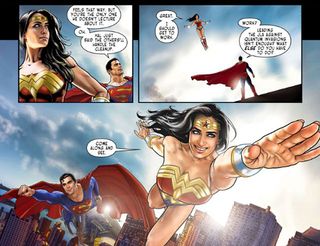
I've been a Wonder Woman fan for a long time, almost as long as I've been a Batman fanatic. I remember the clear plastic collar stiffs from my dad's new dress shirts, wrapping them around my wrists and pretending that I had invisible bullet proof bracelets.
Of course I fell in love with the Wonder Woman from the 1970s TV show. The Linda Carter Wonder Woman was beautiful, but also strong and caring. I don't think it's a coincidence that the woman I fell in love with and married happens to be Amazonian in stature but also shares the same birthday as the most famous Amazon (22 March).
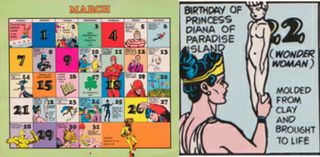
But Wonder Woman, for me, suffered from lacklustre writing and stories while Batman got all the good artists and writers. In the 1980s, 1990s, and into the 2000s, the stories always seemed to want to do to something with her character other than what she was: make her a spy, make her a warrior, basically make her more masculine.
Sensational Comics starring Wonder Woman has become my favorite series, and not just because Wonder Woman is one of my favorite characters. The stories are quick, clear, and don't require you to have read the last five years of the entire DCU to understand each panel.
I first met Jason Badower at San Diego ComicCon in 2007. He was an up-and-coming comic book artist from Australia who had drawn the cover of a comic book that I had worked on as part of AOL RED with Top Cow Comics. So, I was elated to see that he drew issue #48 of digital first Sensation Comics, which will be coming out in print this week as a part of Sensation Comics Featuring Wonder Woman #16.
Badower not only drew the story but wrote it as well, including a stunning scene where Wonder Woman officiates at the wedding ceremony for a gay couple, giving us one of the best lines from any comic I've read recently: "Clark, I come from a country that's all woman. We don't call it 'gay' marriage. We just call it marriage."
So how did Badower do it? Here are a few of his tips for aspiring designers and artists drawn from his own experience.
Get the Creative Bloq Newsletter
Daily design news, reviews, how-tos and more, as picked by the editors.
01. He knows his tools
Jason Badower: "I'm a PC user because my vice is gaming. As a lovely coincidence, a good gaming computer is a good drawing computer. I draw on a 21UX in Photoshop CC 2014. My computer is starting to get a little long in the tooth. It's a Intel I7–3820 3.6 GHZ with 4 GB 1866 MHZ DDR3 RAM (huh, I thought I had more RAM than that) and a GTX970. I shoot my photos on a Canon 60D."
02. He collaborated, but didn't compromise his vision
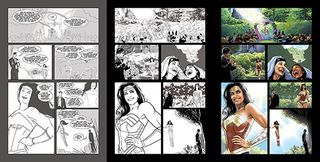
JB: "I came up with the whole idea and pitched it to Sensation Comics editor, [DC Comics Editor] Kristy Quinn over lunch. This initial pitch included the gay marriage. She consulted the schedule, realized she had a window for me and said, "Let's do it!".
"The main direction I got from Kristy regarded [was a scene where] Wonder Woman protects an African village from machine-gun wielding guerillas. She then enlists those guerrillas to protect the village by swearing on her lasso. Kristy liked the scene but we both agreed it was 'low hanging fruit'. Upon reflection, neither of us wanted to engage that tired trope of the 'great white person saving a helpless village of colored people'.
"Kristy challenged me to come up with something else. Then I remembered Crimea. Suddenly, the whole angle of Wonder Woman as international diplomat (a skill-set Superman doesn't have) suddenly came to the fore. So, without Kristy challenging me, we wouldn't have had a scene that worked much better in scale, tone and character."
03. He drew life from life
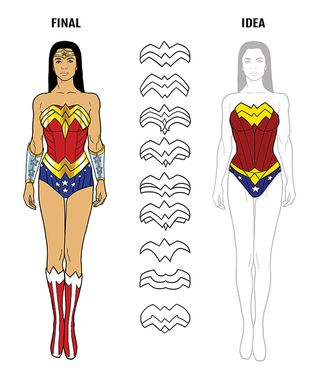
JB: "The work of Alex Ross and Tim Bradstreet, moved me towards developing a realistic style. I found that when you look at their work you feel like you're seeing characters for the first time. It's like you realized your glasses were dirty for all these years and suddenly you can see them clearly. I love the idea that these characters should look so real that when they step into the air and don't come down, it should engender a sense of wonder and awe.
"I then looked into their process and they (like the classic artists) use models. But comic books are about storytelling and just having a model isn't enough for me. I need someone who can act, emote and perform. From the moment I met her, I knew who I wanted to play Wonder Woman.
"I approached my friend, model, host and actress Donna Feldman. Donna is statuesque. She's five foot 10, smart, elegant and a consummate professional. She's completely Wonder Woman (except she has brown eyes). She's a huge Wonder Woman fan, and we managed to find two hours in her extremely busy international schedule for her to play Wonder Woman in my Sensation Comics story.
"One of the reasons I love working with models is that making comic books is a very solitary art-form. This gives me the opportunity to work with a bunch of great people. But the main reason is that I love the performance I get. I get to put on my director hat and help create moments and a performance arc across the story. Given how deadline driven comics are, us artists fall into a lot of repetitive habits. Working with a model gives you something fresh and unexpected every panel."
04. He knows his characters
JB: "Having a person there who you respect immensely informs how you depict the character. I don't believe in 'cheesecake', 'good/bad girl' shots for Wonder Woman. I haven't drawn any shots where she's got her butt sticking out or we're staring down her cleavage. While Wonder Woman's avatar/branding changes from creator to creator, I always saw Wonder Woman as the mother or big sister of the DC Universe.
"That's not to say her beauty shouldn't be celebrated, but that she should be given the same respect visually as your mother or sister. I feel this depiction is friendlier to both genders, and especially those people and children who look up to the character."
05. He made the mundane exciting

JB: "Working with a model always makes things fresh and unexpected. Take something as mundane as drinking a cup of coffee. How anyone does that says so much more about the character and the performance than you could ever hope to inject. They'll lean forward or back or put their weight on a hip you didn't expect creating a powerful silhouette or image from a frame that would have normally been unremarkable. And different bodies move differently. We think that everyone moves/sits/eats like us, but they don't. That subtlety of performance makes the character more believable and convincing."
06. He saw the light
JB: "And then there's light. The way it sits on clothing, the way it falls across a face. It can sometimes be so unpredictable and interesting. But I'm not breaking any new ground here. These are all techniques pioneered by the great masters and the way they used models. The main difference is I don't need them to stand there all day for a single pose. I have a digital camera.
"As for the shoot itself, I shoot very lo-fi. I joked to Donna that it was probably the most ghetto shoot she's done in over 20 years. I just shoot in my living room using construction lights. Why? Because if the photo is too finished there's nothing for me to do. I like to solve the problems that rough photos give me. It keeps me engaged, learning and active while drawing. I have no interest in tracing perfect photos. It's boring. While I love beautiful photos, I'm not interested in the level of skill and hardware required to achieve that level of fidelity. I shoot my photos for performance.
"Donna is an international supermodel. We're friends, so she was too polite to be openly skeptical when I warned her about the low-tech setup. When she saw the final artwork she couldn't believe how I got these rough photos to that stage.
"I mean, why would I spend thousands on every sort of lighting setup imaginable when I've studied how light works? I can draw the light from a South American jungle to a fictional Metropolis. It's much more fun this way too."
07. He let the pictures guide, but not dictate, his art
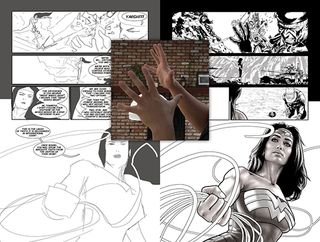
JB: "The pictures are always just a guide. While performance is key, I've found that what looks 'right' in a photo doesn't necessarily look 'right' as an illustration. I also change what needs to be changed to create a greater sense of dynamism and movement.
"But using models has a drawback. The trick is being a good enough artist that when you don't have a model that you can blend your imagination with the model's performance. For example, in Sensation Comic, I had Donna for Wonder Woman, but there was no Superman. She basically green-screened everything and I drew him in after. Every page was a challenge to make him as real as her.
"I also didn't change any of the story to fit the photos. For me, script is key. There's also no dialogue improvisation on a shoot. Although, once I saw the shots, I did change some panel framing. Sometimes a certain angle would inspire a different depth or alignment to make it look nicer or heighten some aspect of the performance. That's always fun to see how different media contribute to storytelling."
Words: Jason Cranford Teague
Jason Cranford Teague is a Senior Creative Director at Capital One and teaches workshops on experience design for developers, development for designs, and temporal design thinking.
Like this? Read these...
- How to draw and paint - 90 pro tips and tutorials
- 13 inspirational comic artists to follow on Instagram
- Marvel illustrator on managing your demons

Thank you for reading 5 articles this month* Join now for unlimited access
Enjoy your first month for just £1 / $1 / €1
*Read 5 free articles per month without a subscription

Join now for unlimited access
Try first month for just £1 / $1 / €1
The Creative Bloq team is made up of a group of design fans, and has changed and evolved since Creative Bloq began back in 2012. The current website team consists of eight full-time members of staff: Editor Georgia Coggan, Deputy Editor Rosie Hilder, Ecommerce Editor Beren Neale, Senior News Editor Daniel Piper, Editor, Digital Art and 3D Ian Dean, Tech Reviews Editor Erlingur Einarsson, Ecommerce Writer Beth Nicholls and Staff Writer Natalie Fear, as well as a roster of freelancers from around the world. The ImagineFX magazine team also pitch in, ensuring that content from leading digital art publication ImagineFX is represented on Creative Bloq.
